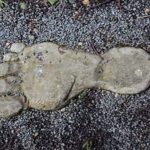
New Species of Large Bird-Like Dinosaur Unearthed on the Isle of Wight
Jocelyne LeBlanc December 26, 2021
An ancient bird-like dinosaur that was discovered on the Isle of Wight is a newly identified species. Named vectiraptor greeni (after Mick Green who found the bones), it was a relative of the Velociraptor and was part of the dromaeosaurs (or raptor) dinosaur group.
The remains were found on the south coast of the Isle of Wight when they washed out from the rocks. After analyzing the bones, scientists from the universities of Bath and Portsmouth have confirmed that it is the first large raptor that has ever been found in the United Kingdom.
As for its physical characteristics, Dr. Nick Longridch from the University of Bath went into further details by stating, “This was a large and very heavily constructed animal,” adding, “The bones are thick-walled and massive. It clearly didn’t hunt small prey, but animals as large or larger than itself.”
 (Not vectiraptor greeni)
(Not vectiraptor greeni)
The vectiraptor greeni, which lived about 125 million years ago, was approximately 10 feet in length with large slashing talons on its feet and serrated teeth that would have ripped apart its prey. In regards to this new species being identified, Dr. Longridch noted, “There’s an extraordinary diversity of dinosaurs known in England in the cretaceous, and even after more than a century of study, we continue to find new species.”
Another interesting fact revealed by Professor Dave Martill from the University of Portsmouth was that raptors that were close relatives of the Velociraptor have been unearthed in Mongolia. This indicates that England may have been situated right on an ancient dinosaur travel route. He went on to say that since the dinosaurs from Mongolia and North America were quite similar, it was expected that a raptor would eventually be found in England.
 (Not vectiraptor greeni)
(Not vectiraptor greeni)
“A remarkable number of dinosaur species originate from this small island off southern England. Ancient England was something of a crossroads for dinosaurs. At the time the continents were closer together, with some connected by land bridges. Dinosaurs likely wandered in from North America and Asia, or perhaps swam from Africa. Europe was a sort of crossroads linking the continents,” a spokesman from the University of Portsmouth explained. The study was published in Cretaceous Research where it can be read in full.
An illustration depicting what the vectiraptor greeni may have looked like can be viewed here.
MU*


















